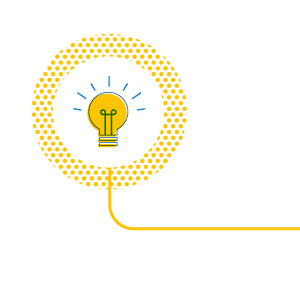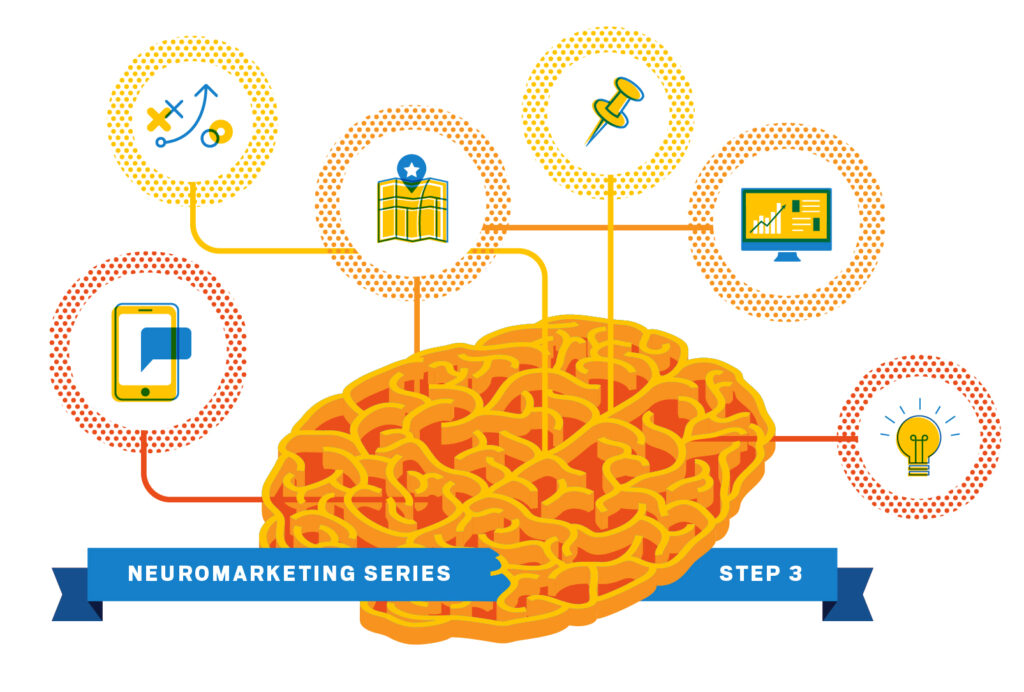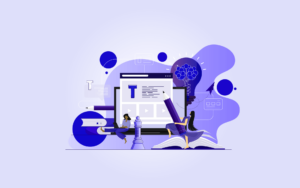“I wish I could read the minds of my wish list clients and know exactly what they were looking for. Then I would build my marketing strategy around that information.”
This was the wish that started our first blog post in a series focused on the fundamentals of neuromarketing and how it helps you connect with your target audience. The critical element that was missing at the time was your target audience insights. Now you have the insights and data to put to work.
As we’ve reiterated throughout the series, neuromarketing studies tell us that the more personalized your marketing can become, the more likely you are to catch the attention of decision makers scanning for solutions. You can create your personalized marketing strategy when you use the insights you gained through your target audience research, and the interview data you collected while creating your marketing personas.
Now let’s put your insights and data to work. Below are tips we’ll walk you through, grounded in the fundamentals of neuromarketing, to help you:
1) Create brain-engaging marketing assets, via:
o Content missing from current industry websites
o Current clients
o Testimonials
2) Repurpose existing content to be more personalized, using:
o Strategic visuals inserted into text-heavy areas
o Website landing pages
o White papers and pamphlets
3) Build a persona centered content calendar, from your:
o Data and insights
o Target audience defined groups
o The decision-maker’s journey

 1) Create Brain Engaging Marketing Assets
1) Create Brain Engaging Marketing Assets
The Missing Content
During your interviews you will have uncovered critical parts of the decision maker’s journey. One of the gems that usually emerges is the content they were looking for but couldn’t find. The interviewee makes a statement along the lines of “I wish I had found a more in-depth comparison table with additional variables” or “I was looking for an interactive video demo and I couldn’t find it.”
These comments help you focus on the exact content you need to create. We recommend first creating a list of what you hear, and then assess how to create this missing content. This will also give you the opportunity to circle back with the decision makers to show them you were listening.
Current Clients
A brief scan of most marketing materials will show you that the majority of the content created is meant to bring new clients through the door. If you plan from the start to keep connecting with and build the relationship with the clients you already have, there will be no awkward lapses in communication. Keeping your existing clients connected to you requires an engagement strategy.
Your interview insights will give you indications about how your decision makers expect to be engaged. Most will start looking for a new product or a new service provider because they feel their current relationship is unsatisfactory. Common complaints we hear during client persona interviews are “once the deal was signed, they disappeared;” “they never asked for any feedback or suggestions;” or more specifically: “our main contact disappeared and now we go through a customer service center.”
Data we’ve collected from decision makers who made a substantial purchase in the last year revealed that a client satisfaction survey (done in person or over the phone) at the 3 and 6-month mark post-purchase was rated as highly appreciated. These decision makers felt engaged and active in building this new business relationship.
It is never too late to start communicating with your clients even if years have passed. Create a client-focused survey and let them know that you’re working towards service and product improvements. Start with an email and follow up with a call. Let them know that you are focused on being their problem solver. And always, always follow through.
Testimonials
Testimonials are a powerful marketing tool that personalize your company. They are micro stories that capture the essence of a decision maker’s journey from dealing with their frustrations, to how your products and services have positively impacted them.
Sharing testimonials with your target decision makers is powerful because they see themselves within these short stories. They see their own pain points captured – and they see you’ve been able to meet the needs of your current clients. Effective testimonials resonate with the brain because they are emotional in nature (they should ALWAYS start with the pain and frustration) and there is built-in contrast in their story arc – before your services and after your services were implemented.
Notice we specify effective testimonials. Simply posting a testimonial that says, “Greg and his team do an excellent job – we couldn’t be happier” is not an effective testimonial. An effective testimonial starts with the trigger, moves into the journey and ends with the resolution. Here’s an example:
“We were spending so much time and money trying to keep the equipment up and running through each phase of the experiment. A colleague recommended Greg and his team to come in and show us how to better maintain and calibrate the equipment and they were here within days. Our lab has never operated so efficiently before and we’re already saving money from inaccuracies. Greg and his team do an excellent job – we couldn’t be happier.”

 Repurpose Existing Content to Be More Personalized
Repurpose Existing Content to Be More Personalized
Text Wall of Death
A guaranteed way to improve the quality of your content quickly and without substantial re-writes is to create areas of visual interest across all your content. Areas of visual interest can be created using techniques such as changes in font size, variations in font color, paragraph spacing and images. These techniques are important because they help to grab brain attention. They catch the scanning eye because they break up long streams of text.
Your visuals need to capture the emotions and contain the key words that speak to your target audience. Social media platforms are the amplifiers of your website content, but don’t keep your audience sitting on Facebook, Twitter or LinkedIn. Use strong and engaging visuals to draw the decision makers back to your home – your website. It takes a bit more time to create and share custom visuals but it is time well spent. Words alone will not capture scanning eyes and will not be remembered.
Are your visuals complementing your marketing objectives? Ultimately all your external marketing content should be designed with one goal in mind: driving decision makers to your website or landing page to learn more about you. Are you effectively drawing the visitor’s eye to the call to action? You need to combine a brain engaging visual with an effective use of white space in order to catch the eye. A visual crammed into text, no matter how personalized, will still get lost amongst the words.
Website Landing Page
Visitors to your website will make a snap judgement, within seconds, whether to click away or explore. And it won’t be based on your expertise or your content but on how your site looks – that initial feeling it gives your readers when they land on the page. That first impression will be based initially on the visual. The colors you have selected, the fonts, the design, the layout of the page, the key words that stand out – these elements contribute to the overall emotion triggered without ever substantially reading any text.
Think about your latest campaign. Do your visitors land in a space that addresses the problems they’re facing and how you can solve them? In our experience, most website landing pages focus on the services provided, products sold and how amazing the team is – all about you and not them. Every other website a decision maker is visiting will be the same, so what is going to capture their attention long enough to explore your products and services? How are you going to persuade them to download a sales sheet or sign up for your newsletter?
Engage the brain by building a landing page that is all about them. You already know what their problems are, the hurdles they’re facing in the decision-making process, the emotions they are experiencing and the key words and key phrases they are using. You collected all those insights during your persona interviews. Now you need to put those insights to work because you only have a second to grab their attention.
White Papers and Pamphlets
The rigorous review you gave your website landing page also needs to apply to your most frequently downloaded marketing asset. For companies in the science industry, this is typically a white paper or pamphlet.
Read through them again to see where you can include the key words, key phrases and other interview insights gained. These assets should be highly personalized to the decision makers you are trying to connect with. You can keep graphs and statistics, – the information that reinforces how effective your services and products are, – but remember that it is emotion guiding the decision making process.
When implementing persona interview insights, an often neglected part is the wording of the call to action (CTA). The insights you’ve gained are not only for the assets. The CTA should suggest that the solution to their pain and frustration is only a click away. This would also be a great location to share an effective testimonial to further persuade your decision maker.

 Build a Persona-Centered Content Calendar
Build a Persona-Centered Content Calendar
Use the Data and Insights
The foundation of neuromarketing is marketing designed to engage the brain. The most effective way to engage the brain is to create content that is personalized to how the decision maker feels and communicates. Casting a broad audience net is not an effective way to build a client base or an engaged community of supporters and advocates.
We have worked with companies who have analyzed their audience and created a persona, only to let their efforts sit in one or two new content pieces. The data you have now is a business asset and you need to use it across all your marketing efforts. These insights build strategy into your marketing plan and save you time in the long run: Your content calendar will be guided by the relationship you want to build with your target audience. Show that you understand them, their pains, frustrations, needs and goals.
Target Audience Defined Groups
In the second blog post of this series you defined the groups that make up your target audience. We also walked you through additional research steps in the Persona Builder Guide. Go back to the groups you defined as important to your business goals. Each one of these groups needs your content to be tailored to their specific reason for building a relationship with you. How you sell your services and products to a client is not the same as you pitch your company to a potential investor.
Start with the group that is the most important to your immediate goals and then move outwardly until you cover all essential groups such as clients, strategic partners, investors or board of directors. Build these groups into your content calendar to keep the assets you create, repurpose and share balanced across your groups in a strategic and systematic way.
The Decision Maker’s Journey
The interview data you collected will fall into one of the four defined categories. You need to ensure your content calendar covers each of these areas so you can reach out to decision makers that are at different stages of their journey to find and select your company.
• The Need – content related to their pains/frustrations and your unique solution
• The Search – content specific to how your solution sets you apart in your industry
• The Decision Steps – content they identified as hard to find but essential to their decision
• The Choice – content to keep the decision maker engaged in the long term
Even when the content is about your solutions, the focus is still on the decision makers echoing the insights you have gained.

Our next post in this neuromarketing series will focus on specific ideas for creating content that will engage clients, strategic partners and investors. In the meantime, don’t forget to keep working your way through our Persona Builder Guide. This guide is designed to build a deeper and stronger foundation for your marketing strategy based on the basics of neuroscience and supported by real case studies.


















